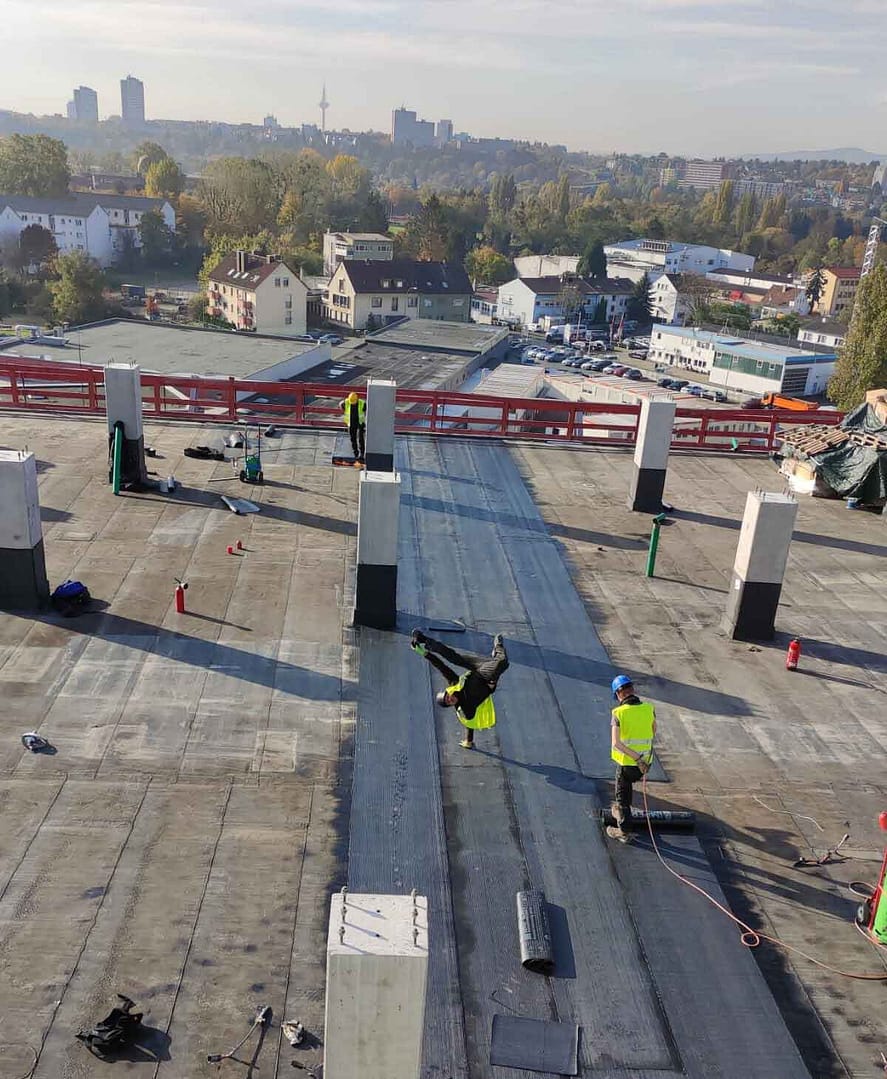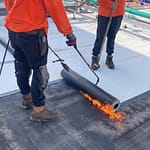Requirements for flat roof structures
Requirements for flat roof structures include water tightness, adequate thermal insulation, vapor diffusion control. Durability, ease of maintenance, resistance to atmospheric effects, fire and the ability to integrate various engineering systems are also important. Constructions must be adapted to the local climate. In one place it rains more, in another there is more sun or wind.
Durability, weather resistance
Depending on the materials, the minimum warranty period is 10 years, if you choose better materials, it can even be extended up to 30 years!
Water impermeability
Perhaps the most important criterion for flat roofs is water impermeability. It is important to have a properly designed arrangement of water leaks and a sealed roof.
Thermal insulation, vapor diffusion
Only a properly designed roof will last for many years without much maintenance or worry. Proper insulation and ventilation is important.
Important requirements for flat roof constructions include several essential areas: firstly, water resistance is ensured to avoid leaks and moisture accumulation. Secondly, thermal insulation is necessary in order to reduce heat loss and ensure energy efficiency. Third, vapor control and ventilation are important to prevent condensation and mold growth. In addition, panel roof structures must withstand local climatic conditions, including wind loads, snow weight and temperature fluctuations. It is also important to ensure mechanical resistance and durability, low maintenance requirements, and the ability to integrate solar panels or other ecological systems. An important aspect is aesthetics, so that the roof matches the architecture of the building.
Contact us and we will advise you from experience on the best materials according to your needs. We will prepare a flat roof installation project, we will offer goods directly from manufacturers, and if you wish, we will install your new flat roof.
- The flat roof structure must be designed and installed in such a way that it performs its functions under normal weather-related temperatures (from -30 0C to +80 0C).
- A flat roof must have a water drainage system that does not harm the building's construction structures and the environment (greenery, sidewalks, streets, other structures).
- Flat roofs with a slope between 0.70 (1.25%) and 2.90 (5%) must be of particularly reliable construction to reduce the risk of leaks due to the possibility of standing water.
- The slope of the roof must be formed in such a way that water does not remain on the roof for more than 4 hours after rain.
- Materials used in roof constructions and their installation must comply with STR 2.05.02:2001 "Construction of structures. Roofs" and the requirements of Lithuanian standards.
Requirements for waterproofing roof coverings
The requirements for waterproofing roof coverings are strict in order to ensure the maximum level of durability. The most important aspects include high water resistance, which prevents moisture from entering the structure. Resistance to the effects of UV rays and temperature fluctuations ensures the durability of the coating and maintenance of unchanged properties. Coatings must be resistant to mechanical damage, chemicals, and also have elasticity that allows them to adapt to the expansion or contraction of the roof. Ecological safety, easy installation and maintenance procedure are also important factors that ensure that waterproofing coatings are durable and reliable.
The waterproofing coating of the roof must be installed in such a way as to ensure long-term waterproofing protection of the building and operational reliability of the roof.
Roof coverings are selected taking into account their technical characteristics, the nature of the work to be performed (installation of a new roof, renovation or capital repair) and the slope of the roof, the base on which they are laid. Climatic conditions, type and thickness of thermal insulation materials, roof structures and their possible movement must also be evaluated.
The waterproofing of a new or renovated roof must be installed from two layers of polymer bituminous coating that are fully bonded to each other, where the top layer of the coating is sprinkled with coarse-grained mineral barstal (shale).
In the case of a capital repair of the roof covering, when the old waterproofing layer is completely removed, it is recommended to install the roof waterproofing from two covering layers, as in the case of a new roof.

arrangement of flat roofing layers
The placement of roofing layers is an important choice that ensures durability and functionality. Start by preparing a firm and smooth base. The first layer is vapor insulation, which prevents moisture from entering from the inside. A heat insulating layer is placed on it, which reduces heat loss. At this stage, it is important to ensure the appropriate thickness of the thermal insulation, which meets the requirements of the thermal efficiency of the building. The next layer is waterproofing, which ensures resistance to water, UV rays, temperature changes and mechanical impact. It is important that all layers are properly joined and sealed, ensuring complete watertightness and optimal insulating properties. Finally, pay attention to the correct installation of details such as ventilation openings, rain drainage systems and skylights.
Contact us - the flat roofing professionals. We will help you to quickly and qualitatively perform all preparation and execution work. We will advise and select the best solutions on the market.






